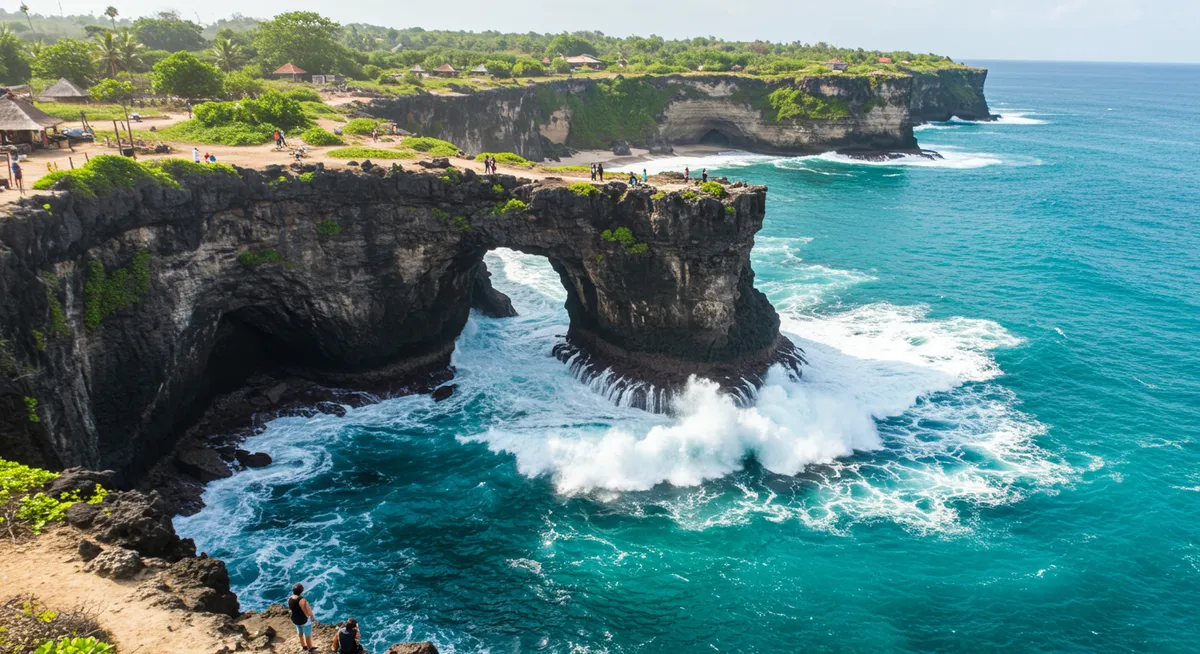
Devil's Tear Nusa Lembongan: Your Guide
Table of Contents
Want to find the best travel deals for this destination? Chat with our travel hacking specialist!
Get Travel HacksCategory: devils-tear-nusa-lembongan-guide
Experience the Raw Power of Devil's Tear Nusa Lembongan
Having explored Nusa Lembongan extensively on several trips, I can confidently say that Devil's Tear is one of its most mesmerizing natural wonders. This dramatic coastal outcrop, where massive waves crash against jagged cliffs, creating spectacular blowholes and sea sprays, truly encapsulates the raw power of the ocean. Our comprehensive Devil's Tear Nusa Lembongan guide will walk you through everything you need to know for a safe and unforgettable visit, from understanding the best viewing conditions to navigating the area. For a broader overview of this charming island, don't forget to check out our Nusa Lembongan travel guide.
What Makes Devil's Tear So Unique?
Devil's Tear isn't just a viewpoint; it's a dynamic display of nature's might. Here, the ocean's immense force relentlessly pounds the volcanic rock formations, resulting in powerful blowholes and dramatic splashes. Witnessing these colossal waves is truly breathtaking. From my personal experience, the sheer scale of the sea spray can be astonishing, often creating rainbows in the mist. The raw, untamed beauty of this coastal spectacle makes it a must-see. For the best visual impact, consider aligning your visit with high tide, which usually amplifies the crashing waves. Understanding the best time to visit Nusa Lembongan generally can also help you plan your trip for ideal weather conditions, ensuring a clear view of the iconic Devil's Tear Nusa Lembongan.
How to Get There & Best Time to Visit
Reaching Devil's Tear is quite straightforward once you're on Nusa Lembongan. It's located on the island's southwest coast, easily accessible by scooter or taxi from most accommodations. Roads leading to it are generally well-maintained. The prime time for visiting is during high tide when the wave action is at its most spectacular, making the blowholes truly impressive. Moreover, arriving about an hour before sunset offers a magical experience; the golden light illuminates the spray, creating stunning photo opportunities. However, expect larger crowds during this peak time. Getting to Nusa Lembongan from Bali is also simple, typically via a fast boat, and once you're on the island, a short ride will bring you to this natural wonder, the celebrated Devil's Tear Nusa Lembongan.
Safety Tips for Visiting Devil's Tear
While incredibly beautiful, Devil's Tear demands respect for its raw power. Safety is paramount. Always maintain a safe distance from the cliff edge, as rogue waves can unexpectedly sweep over the viewing platforms. The rocks can also be extremely slippery due to constant sea spray. I've personally seen visitors get soaked by unexpected waves, so be aware of your surroundings and any warning signs. Never turn your back to the ocean, especially when close to the edge. Staying behind designated barriers and following local advice ensures a safe and enjoyable experience at this iconic natural site. Prioritizing caution is key to a memorable visit to the stunning Devil's Tear Nusa Lembongan.
Photography Tips & Nearby Attractions
Capturing the majesty of Devil's Tear requires a bit of planning. For dramatic shots, try to photograph the blowholes from a slightly elevated position, emphasizing the scale of the waves. Golden hour (sunrise or sunset) provides incredible lighting for both the ocean and the surrounding cliffs. Nearby, you'll find Dream Beach, a beautiful white sand cove perfect for relaxing after the intense spectacle of Devil's Tear. There are also several charming cafes and warungs in the vicinity where you can grab a refreshing drink or a meal with a view. Integrating Devil's Tear into a broader Nusa Lembongan itinerary often includes combining it with a visit to these adjacent attractions, making for a well-rounded day of exploration.
Frequently Asked Questions
Is Devil's Tear dangerous?
What is the best time to visit Devil's Tear?
Are there any facilities at Devil's Tear?
Visiting Devil's Tear Nusa Lembongan is an absolute highlight for anyone exploring the island, offering a profound connection to the raw power of nature. By keeping safety at the forefront and timing your visit strategically, you're guaranteed to witness an awe-inspiring spectacle of crashing waves and dramatic blowholes. Remember to bring your camera for truly unforgettable shots and consider pairing your visit with the nearby Dream Beach. Make the most of your Nusa Lembongan adventure by including this incredible natural attraction in your itinerary. Explore more of Nusa Lembongan's wonders and plan your perfect getaway today!